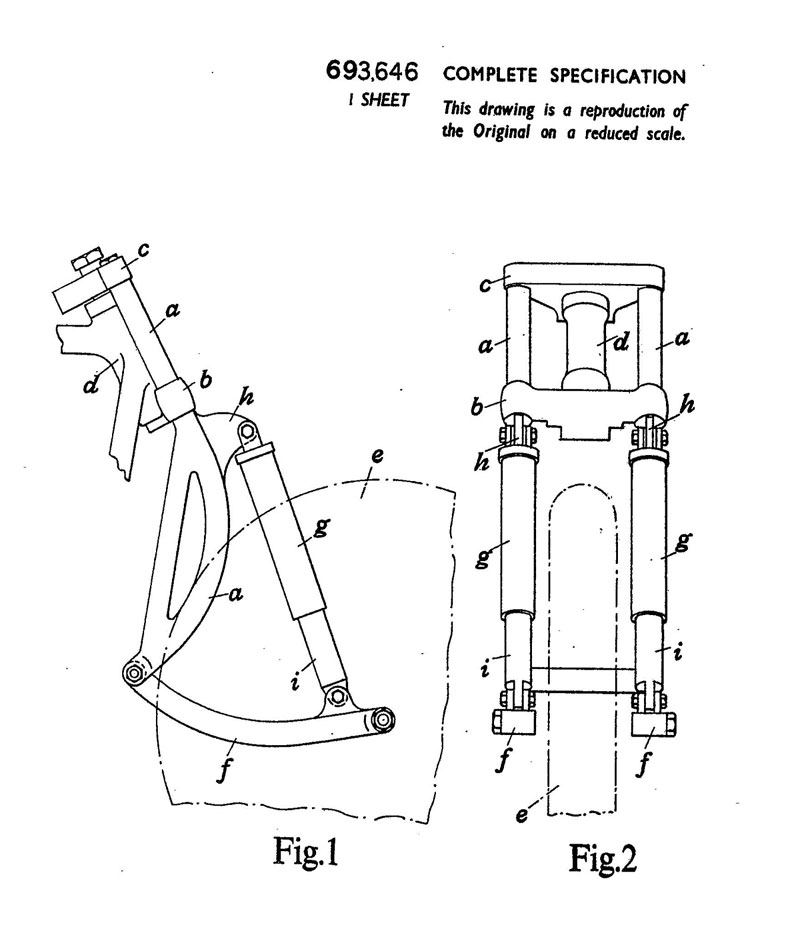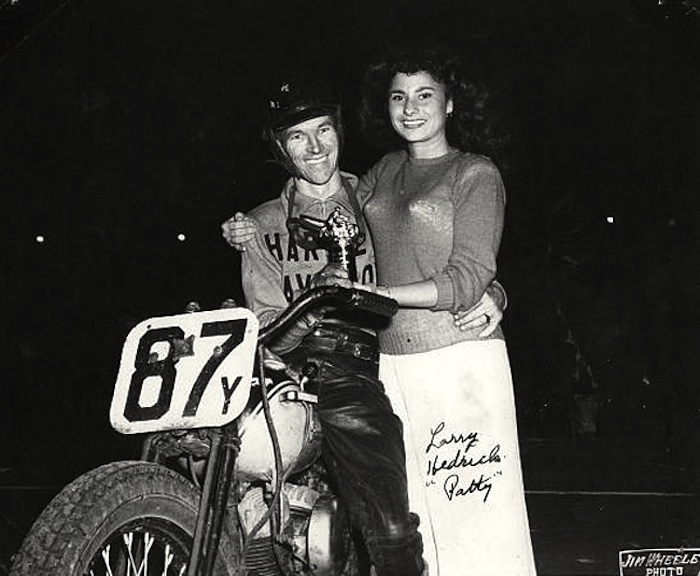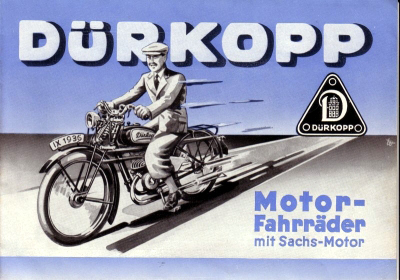Monday, December 8, 2014
Today in motorcycle history, December 8, 1972
Australian Speedway 'Legend' Jack Biggs is killed when he crashes his 500cc JAP machine on Bendigo's (Victoria) Golden City Speedway. It was the same bike he'd been racing for twenty-four years.
Today in motorcycle history proudly supports the National Association for Bikers with a Disability (NABD). www.nabd.org.uk
Friday, December 5, 2014
Today in motorcycle history, December 5, 1951





Ernest Richard George Earles applies for a patent for his leading link fork. Filed under "Motor Cycle Front Wheel Forks", the Earles Fork is born.
The Earles fork was a variety of leading link fork where the pivot point was aft of the rear of the front wheel — this was the basis of a patent for the design. This triangulated fork actually caused the front end of a motorcycle to rise when braking hard — the reverse of the action of a telescopic fork.
Possibly the greatest benefit of the Earles fork in sidecar use was its adjustability for rake and trail. The swinging arm pivot had two positions. Moving it to the forward position reduced trail, allowing the bike to turn with less effort when a sidecar was attached.
Several motorcycle manufacturers licensed the Earles patent forks for racing motorcycles in 1953, such as MV Agusta and BMW, while other companies such as Douglas used the Earles design on their roadsters or off-road machines. BMW is best known for their use of Earles forks, as from 1955 to 1969 they were featured on every BMW motorcycle.
Today in motorcycle history proudly supports the National Association for Bikers with a Disability (NABD). www.nabd.org.uk
Thursday, December 4, 2014
Today in motorcycle history, December 4, 2006




Aprilia Vice President Leo Mercanti had a shit-eating grin on his face as he showed a number of their new bikes and products at the 64th EICMA International Milan Motorbike Show (EICMA 2006).
The '06 Milan Aprilia exhibit was highlighted by four completely new products: an automatic transmission unit called the 850 Mana, a new mid-size entry called the SL 750 Shiver, a new motocrosser dubbed the “MXV”, and a four-cylinder, 200hp engine capable of powering the brand in future MotoGP competition.
The Mana 850 is powered by a 90-degree V-twin engine delivering 75 hp at 7250 rpm. However, the focal point of the innovative bike was without a doubt the electronically controlled seven-speed sequential transmission that allowed a rider to switch from automatic mode to sequential mode at any time and in any riding condition.
In automatic mode, everything is controlled electronically. The CVT transmission enables the engine to be run at maximum torque at all times, emphasizing pick-up and acceleration. The electronic control system has three different mappings — Touring, Sport and Rain — enabling the rider to choose the type of operation most appropriate to the situation.
In Sequential mode, the rider would choose the gear by means of either the control on the handlebars or a pedal command. A servo-assisted mechanism acts mechanically on the main pulley, making changing between the seven ratios extremely rapid.
The SL 750 Shiver also contains some unique traits, including “ride by wire” electronic management of the accelerator.
The “ride-by-wire” engine management unit controls all engine parameters. All data passes through a CAN (Controlled Area Network) line to the instrument panel, which also acts as a diagnostic terminal. The CAN line uses just two wires to transmit all data.
Powered by Aprilia’s new 90-degree V2 engine producing 95hp, the 416-pound Shiver is further outfitted with a 43 mm upside down fork, lay-down shock absorber resting directly on the swingarm, and the biconical aluminium handlebars from the Tuono. Stopping power comes from braided brake lines hooked to radial-mounted calipers using the same 320 mm front disks mounted on the the RSV 1000 and Tuono 1000 R.
The next new Aprilia product that was shown, the MXV 450, it was the third bike in the company’s “V” range, joining the enduro RXV and supermoto SXV.
Finally, Aprilia’s new 999cc, 65-degree V4 engine produces more than 210bhp at 13.500rpm. The company says it will start testing the engine in a brand new chassis this spring, and plans on the first finished version to be at next year’s EICMA show for a 2008 attack on the World Superbike crown.
Geez, my pan has a kickstart, a four-speed and an ignition switch wired backwards that I was too lazy to change.
Today in motorcycle history proudly supports the National Association for Bikers with a Disability (NABD). www.nabd.org.uk
Today in motorcycle history proudly supports the National Association for Bikers with a Disability (NABD). www.nabd.org.uk
Tuesday, December 2, 2014
Today in motorcycle history, December 3, 1920




1950 AMA Grand National Champion and AMA Hall of Famer, Larry Headrick is born in Wichita, Kansas.
Larry Headrick had a brief, but spectacular racing career. In 1950, he rode a Tom Sifton-prepared Harley-Davidson to three AMA National wins on mile dirt ovals, including earning the National Championship at Springfield, Illinois. Larry's upset victory at Springfield that year was one of the most surprising in the history of the race.
Despite his victory at Bay Meadows two months earlier, Larry Headrick was still a long shot at winning the coveted number one plate. At Springfield Paul Goldsmith took the early lead in the 25-mile final on a factory Harley with Larry close behind. At one point, Headrick said that Goldsmith tried to shake him off by intentionally pelting him with a thick roostertail. Then Goldsmith's bike broke an axle and Headrick found himself in the lead. He faced one more challenge when (the legendary) Bobby Hill came past and put his Indian into the lead. Late in the race, Hill's bike began to slow and Headrick slipped by to earn the win and with it the 1950 AMA National Championship.
Headrick became the first West Coast rider to win the Springfield Mile.
A week later, he proved his Springfield Mile win was no fluke when he came out on top again at the Milwaukee Mile. Headrick had practically come out of nowhere to win three of the biggest races of the year. It is one of the great stories of "overnight success" in AMA racing history.
Sadly, Larry Headrick's career was cut short at the end of the 1950 season when he was hit by a car while riding his motorcycle on the street. The accident shattered his left leg, making it impossible for him to race again on the dirt-track ovals. At 30, with a bum leg and four rug-rats to feed, Headrick decided to give up racing.
Larry Headrick was inducted in the AMA Hall of Fame in 1998.
Today in motorcycle history proudly supports the National Association for Bikers with a Disability (NABD). www.nabd.org.uk
Today in motorcycle history proudly supports the National Association for Bikers with a Disability (NABD). www.nabd.org.uk
Monday, December 1, 2014
Today in motorcycle history, December 2, 1964
The Research & Development team at Suzuki has it's sights set on the perfect 125cc.
Honda had a new four-cylinder developed known as the RC 146. Suzuki then assumed that two cylinders would not be enough to win with in the future. Immediately following the 1963 Japanese Grand Prix Suzuki began the development of a square-four, water cooled engine, internally called RK64. But the development of the machine wasn't finished until the season was already over. The completed engine design was turned in on December 2, 1964 and first engines would hopefully be built in February of 1965.
Then the development team changed the name to RS 65. The bike still some technical difficulties, including sky-high oil temperatures. After a month of frustration it was decided to start with a new direction, the three-cylinder RJ 66 , which one would start in November of 1965. The old racer, the water-cooled two-cylinder, was now called the RT 65. Confused yet?
1963, '64 and '65 Japanese 125cc GP's had Suzuki feeling like it could keep the title forever. There appeared only one cloud on the horizon: Yamaha had a water-cooled version of the RA 97 made.
Today in motorcycle history proudly supports the National Association for Bikers with a Disability (NABD). www.nabd.org.uk
Today in motorcycle history, December 1, 1965



German engineer Fritz Gosslau dies in Grünwald, Bavaria.
Better known for his work during WWII on the V-1 flying bomb (Fieseler Fi 103) an unmanned, explosive payload missile. After the war he turned his talents to motorcycles becoming the head designer for Durkopp in 1948.
Fritz Gosslau designed their most successful model, the MD150. Introduced in 1952, it featured a 150cc three-speed two-stroke engine with reverse circulation. The machine made 7.5 hp with a top speed of 56 mph. The MD150 is still considered by many to be amongst the best in German motorcycle history. There where 17,890 bikes sold in the period 1951-1954.
Fritz Gosslau designed their most successful model, the MD150. Introduced in 1952, it featured a 150cc three-speed two-stroke engine with reverse circulation. The machine made 7.5 hp with a top speed of 56 mph. The MD150 is still considered by many to be amongst the best in German motorcycle history. There where 17,890 bikes sold in the period 1951-1954.
In 1952 they introduced the MD200 with a 198cc two-stroke engine which increased the speed to 59 mph.
Many racing successes were contributed to the reputation of the MD150 / 200 models. Durkopp celebrated these motorcycles as the "fastest machines in its class."
Friday, November 28, 2014
Today in motorcycle history, November 28, 1964





"Leader of the Pack" by the Shangri Las is Number One on the (U.S.) Billboard charts.
Penned by the legendary producer George "Shadow" Morton and released as a single on Red Bird Records, the label of the legendary songwriting duo of Jerry Leiber and Mike Stoler ("Jailhouse Rock", "Hound Dog", "Spanish Harlem", etc, etc.), the song shoots to number one on the Billboard Hot 100.
High School girl, Betty, falls for a biker, Jimmy, and causes him to crash. Using her "innocent" seductive powers she gets him to fall in love with her (even though he's a loner and doesn't want to be tied down) then she dumps him because he's from the "wrong side of town". Heartbroken, Jimmy revs up his '55 Harley panhead-bobber ('59 BSA A10 in the UK version), takes off on a rainy evening and, unable to stop (due to crappy mechanical brakes), he hits an on-coming candy delivery truck. One of the classic "teenage tragedy" songs.
Is she really going out with him?
Well, there she is. Let's ask her.
Betty, is that Jimmy's ring you're wearing?
Mm-hmm
Gee, it must be great riding with him
Is he picking you up after school today?
Uh-uh
By the way, where'd you meet him?
I met him at the candy store
He turned around and smiled at me
You get the picture? (yes, we see)
That's when I fell for (the leader of the pack)
My folks were always putting him down (down, down)
They said he came from the wrong side of town
(whatcha mean when ya say that he came from the wrong side of town?)
They told me he was bad
But I knew he was sad
That's why I fell for (the leader of the pack)
One day my dad said, "Find someone new"
I had to tell my Jimmy we're through
(whatcha mean when ya say that ya better go find somebody new?)
He stood there and asked me why
But all I could do was cry
I'm sorry I hurt you (the leader of the pack)
He sort of smiled and kissed me goodbye
The tears were beginning to show
As he drove away on that rainy night
As he drove away on that rainy night
I begged him to go slow
But whether he heard, I'll never know
Look out! Look out! Look out! Look out!
I felt so helpless, what could I do?
Remembering all the things we'd been through
In school they all stop and stare
I can't hide the tears, but I don't care
I'll never forget him (the leader of the pack)
The leader of the pack - now he's gone
The leader of the pack - now he's gone
"Leader..." bits for your enjoyment;
Legend has it that to record the sound of the motorcycle, one was driven through the lobby of the hotel and up to the floor of the recording studio. No one was arrested, but allegedly a ticket was issued. In an interview four decades later, Shangri-Las lead singer Mary Weiss said the motorcycle sound was taken from an effects record.
The Zombies' drummer Hugh Grundy recalls revving up a motorcycle backstage when the Shangri-Las performed on a U.S. tour.
Shadow Morton produced the New York Dolls LP, "Too Much Too Soon".
In the 1982 musical Little Shop of Horrors, Ronette, one of the backup singers, says "Here he is, girls, the Leader of The Plaque" during the song "Dentist". Orin, the dentist, notably rides a motorcycle that sounds similar to that in the song.
Today in motorcycle history proudly supports the National Association for Bikers with a Disability (NABD). www.nabd.org.uk
Subscribe to:
Posts (Atom)

